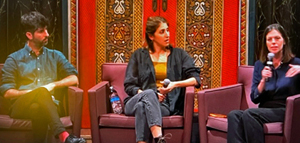Fracking in New York State — Is the Train Out of the Station?
New York State is in the midst of a ramped up fracking debate. On June 25th, the stage is set for a “Day of Action,” with organized and synchronized hyper-local events. Exactly a month prior to this date, I attended an event at the New York Society for Ethical Culture. It was co-presented with Water Defense, a group championed by Mark Ruffalo and Rosario Dawson. Their mission is to build a movement around preventing water contamination.
The title of the panel was “Water at Risk — A Forum on Hydraulic Fracking.” Craig Unger moderated a discussion that included Sandra Steingraber, author of Raising Elijah: Protecting Children in an Age of Environmental Crisis; Robert Howarth, Cornell University biologist; Wenonah Hauter, Executive Director of Food and Water Watch; Weston Wilson, the whistleblower featured in the documentary Gasland.
There was an extended list of co-sponsors, ranging from the Council of Interfaith Congregations of the United States (CICUSA) to the Catskills Citizens for Safe Energy. The lobby leading to the auditorium was lined with tables that had wide-ranging information on how to contact legislators about closing the “Halliburton Loophole,” fighting the proposed Spectra Pipeline — which would run through Northern New Jersey, Staten Island and under the Hudson River before entering Manhattan, or joining the National Grassroots Coalition, organizations opposing fracking across the country. There was even a handout from the New York City Department of Environmental Protection on how to test water suspected of being contaminated due to hydraulic fracking (expose the water to a lighted match).
The underlying premise of the night was that in order for communities to be healthy, living habitats had to be healthy as well. A big take away from the conversation was that the public was being misled by the terminology of “natural gas as a clean energy,” which several of the speakers qualified as a public relations effort spearheaded by the oil and gas industries. With hydraulic fracturing currently sited in thirty-four states, New York is poised to be the next battleground. Most people aren’t aware that in the hydro-fracking process — in addition to the release of gas — toxins including heavy metals and radioactive materials are also sent into the soil, water, and air.
Steingraber spoke passionately about the invisibility of fracking and why the risks have failed to capture the public’s imagination. She illustrated her point with the sardonic observation, “There is no Hubbell Telescope for shale.” Defining the situation as being at a “cross-roads,” she referenced her roles as both an ecologist and a mother when she asked, “What are the consequences for health?” She posited that the process would bring urban style pollution to a suburban setting. Her biggest concern was that fracking was a “disincentive to real renewable energy.” She continued, “It kicks the can down the road and leaves our children with problems.” The following day, Steingraber testified before the New York State Assembly Standing Committees on Environmental Conservation and Health.
Howarth, whose study on the climate footprint of shale gas was published in the May issue of Climatic Change Letters (105:5), maintained that the results of hydrofracking do not yield a clean fuel, and that it could in fact aggravate global warming. He called for the industry to document the amounts of methane gas leakage. His conclusion was that methane gas was worse than coal, and that in thirty years the Arctic ice would be melted. With methane gas presently accounting for 40 percent of the country’s emissions, Howarth asked rhetorically, “Do we step back and say enough is enough? Stop wasting capital and go to green solutions?” He provided his own response stating, “I think the time to stop the process is now.” As an aside he observed, “This isn’t an industry that is looking to do anything to make this process safer.”
Wilson also opined, “Fracking is a large industrial operation. The industry should have industry wide standards.” Having worked at the Environmental Protection Agency for thirty-one years, Wilson applied for protection under the 1989 federal Whistleblower Protection Act in 2004, to bring to light what he considered a flawed report suppressing proven data that there was a risk of toxic chemicals getting into ground water supplies from drilling.
Hauter wants to bring the fracking issue to the voting public as an election issue. She alluded to a powerful lobby working on behalf of the methane industry. She said definitively, “We need to revitalize agriculture, not drill for gas. Using farming land for fracking changes the whole soci-economic structure.” Noting that fracking was a “huge source of profits” and that China and India were partnering with the United States on technology, she pointed to the fact that France has take the precautionary approach of banning fracking. She also stressed that missing in the debate was the fact that “trillions of gallons of water” were used in the fracking process.
Questions from the audience addressed environmental justice, why so many children in communities of color suffer from asthma, and the occupational hazards that would face those who worked in the fracking sector. During the spirited debate on how to best protect the health of children and adults and fight for clean air, an important point was noted. Europeans consume half the amount of energy as Americans.
Hauter had underscored earlier in the evening, “We need to hold our leaders accountable and make them stand up to the methane industry.” On June 25th, the public will have that opportunity.
This article was written for the Moms Clean Air Force blog.




